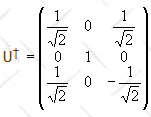 .
.The eigenvalues of H are found from

For the eigenvectors we find

(b) The matrix of U has the eigenvectors as its columns.

Problem 1:
The Hamiltonian operator for a two state system is given by
H = a(|1><1|-|2><2|+|1><2|+|2><1|),
where a is a number with the dimensions of energy.
(a) Find the
eigenvalues of H and the corresponding eigenkets |ψ1> and
|ψ2> (as linear combinations of |1> and |2>).
(b) A unitary transformation maps the {|1>, |2>} basis onto the {|ψ1>,
|ψ2>}
basis. We have U|i> = |ψi>. Write
down the matrix of U and the matrix of U† in the {|1>, |2>}
basis.
(a) In the {|1>, |2>} basis the matrix of H is
 .
.
The eigenvalues of H are found from

For the eigenvectors we find

(b) The matrix of U has the eigenvectors as its columns.

Problem 2:
Let P and Q be two linear operators and
let [P,Q] = -iħ. Find
(a) [Q,P],
(b) [Q,Pn],
(c) [P,Qn] .
Solution:
Problem 3:
Suppose |i> and |j> are eigenkets of some Hermitian operator A. Under what conditions can we conclude that |i> + |j> is also an eigenket? Justify your answer.
Solution:
Using the rules of bra-ket algebra, prove or
evaluate the following:
(a) tr(XY) = tr(YX), where X and Y are
operators.
(b) (XY)† = Y†X†
(c) exp(i f(A)) in ket-bra form, where A is a Hermitian operator
whose eigenvalues are known.
(d) ∑a'ψ*a'(r')ψa'(r''),
where ψa'(r') = <r'|a'>, with {|a'>}
being a basis.
Solution
(a) Let {|i>} denote a basis for the vector space.
tr(XY) = ∑i<i|XY|i> = ∑i∑j<i|X|j><j|Y|i> =
∑i∑j<j|Y|i><i|X|j> = ∑j<j|YX|j> = tr(YX)
(<i|X|j> and <j|Y|i> are numbers and we can
reverse their order when multiplying.)
(b) <i|(XY)†|j> = <XYi|j> = <j|XY|i>*
= <X†j|Y|i>* = <Yi|X†|j >= <i|Y†X†|j>
for any |i> and |j>.
(c) Let {|j>} be the eigenbasis of A, A|j> = aj|i>.
exp(i f(A))|j> = [∑0∞ (i f(A))n/n!]|j> =
[∑0∞ (if(aj))n/n!]|j>
= exp(i f(aj))|j>
<k|exp(i f(A))|j> = =
[∑0∞(if(aj))n/n!]|δkj
= exp(i f(aj))δkj.
For an arbitrary vector
|ψ> = ∑jcj|j>
we have
<ψ|exp(i f(A))|ψ> = ∑j|cj|2exp(i f(aj))
(d) ∑a'ψ*a'(r')ψa'(r'')
= ∑a'<a'|r'><r''|a'> = ∑a'<r''|a'><a'|r'>= <r''|r'>
= δ(r'' - r')
if {|a’>} is a basis.
Assume {|1>, |2>, |3>, ... , |n>} forms an orthonormal basis for the
vector space V. Let Ωij be the matrix
elements of the Hermitian operator Ω in this basis.
Assume that the set {|1>, |2>, |3>, ... , |n>} is not an
eigenbasis of Ω, but that the unitary transformation
U|i> = |ωi>
changes this basis to the eigenbasis {|ω1>, |ω2>, |ω3>,
... , |ωn>} of Ω.
We have Ω|ωi> = ωi|ωi>.
In
this basis the matrix of Ω is diagonal.
Let Uij
denote the matrix elements of the unitary operator in the {|1>, |2>, |3>, ...
, |n>} basis, Uij = <i|U|j> = <i|ωi>.
The
matrix elements of Ω in the {|ωi>}
basis are the same as the matrix elements of U†ΩU
in the {|i>} basis. The matrix of U†ΩU
in the {|i>} basis is diagonal, <i|U†ΩU|j> = 0
if i ≠ j.
<i|U†ΩU|j> = ∑kl<i|U†|k><k|Ω|l><l|U|j>
= ∑klU†ikΩklUlj.
We can therefore diagonalize the matrix
Ω by
multiplying it from the left by U† and from the right by
U.
Consider the matrix

in the {|i>}
basis.
(a) Is this matrix Hermitian?
(b) Find its eigenvalues ωi and eigenvectors |ωi>.
(c) Find the matrix of U in the {|i>} basis.
(d) Find the matrix of U† in the {|i>} basis. (U
changes {|i>} into {|ωi>}.)
(e) Verify that UU† = U†U = I.
(f) Verify that the matrix U†ΩU in
the {|i>} basis is diagonal.
(a) Ω is Hermitian, Ωij = Ωji*.
(b)> det(ωI - Ω) = 0, ω = 1, 0, -1.
ω1 = 1: -c1 + c3 = 0,
c2 = 0,
ω2 = 0: c1 = c3 = 0,
c2 = arbitrary,
ω3 = -1: c1+c3 = 0,
c2 = 0.

are normalized eigenvectors.
(c) Uij = <i|ωj>

The matrix has the eigenvectors as its columns.
(d) U†ij = Uij*

(f) U†Ω U is a diagonal
matrix with the eigenvalues along its diagonal.
